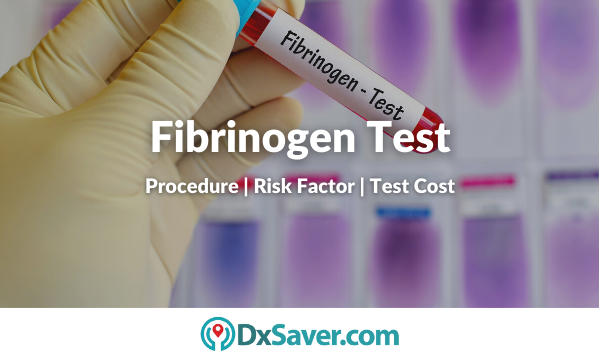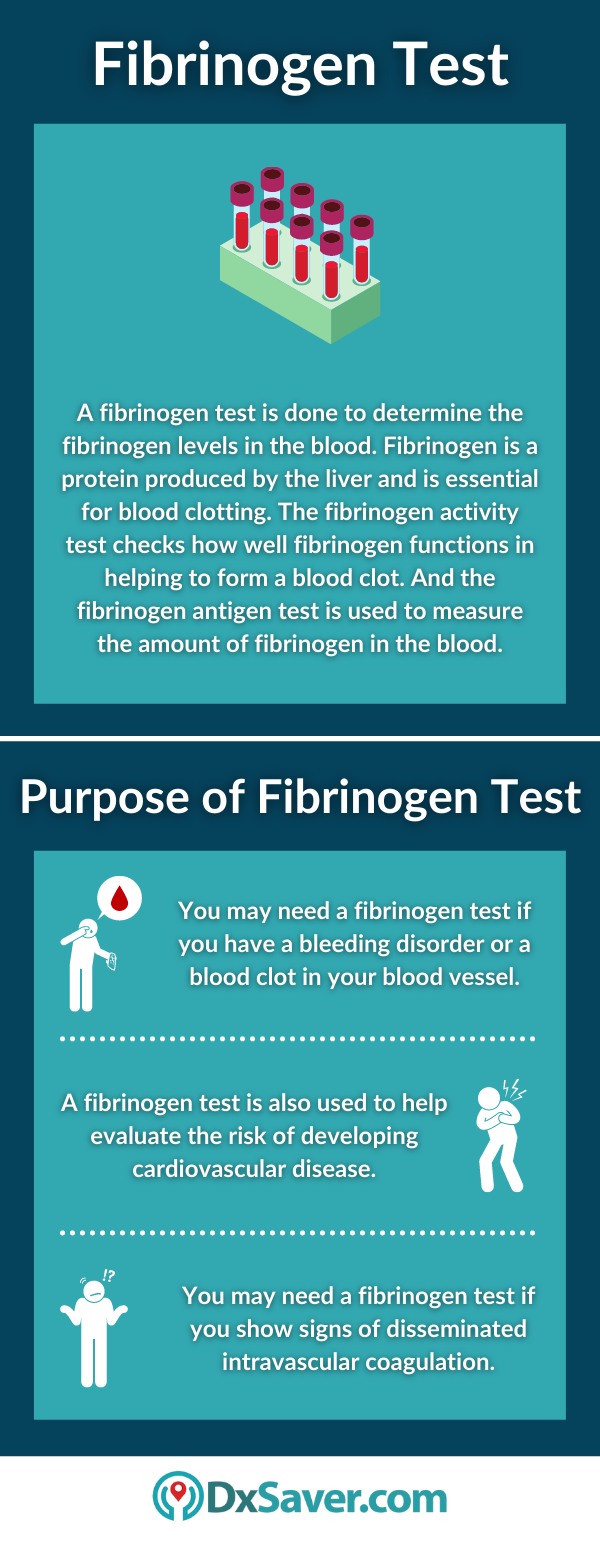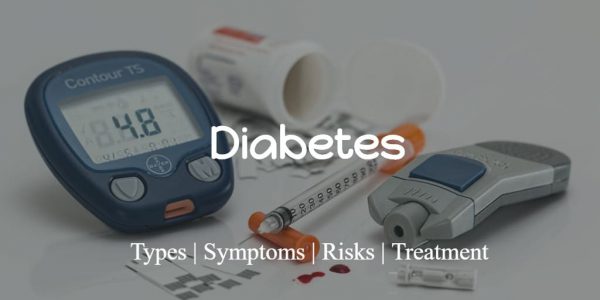
Fibrinogen or coagulation factor I is an important protein made by your liver. When bleeding occurs, the fibrinogen is released from the liver & travels to the site of bleeding to help form a blood clot. A fibrinogen test is done to determine the fibrinogen levels in the blood. There are 2 types of tests to evaluate: the fibrinogen activity test checks how well fibrinogen functions in helping to form a blood clot and the fibrinogen antigen test measures the amount of fibrinogen.
This article covers all the significant topics related to the fibrinogen test such as the test cost, preparation for tests, risk factor, and how to get tested for a fibrinogen test.
- What is fibrinogen?
- What is a fibrinogen test?
- Types of tests
- When do you need a fibrinogen test?
- How should you prepare for the fibrinogen test?
- What happens during the fibrinogen test?
- Risk of this test
- What do the results mean?
- Causes of high fibrinogen
- Provider locations
For our readers who are interested in knowing the fibrinogen test cost beforehand, we begin with that section.
How much does the fibrinogen test cost?
A fibrinogen test costs $62 in the US. Prior appointment isn’t required. You can order tests online by comparing the price or visiting the nearest lab during lab business hours. You will get the results in your email in 2 to 3 business days after completing the procedure. Apart from this, doctor consultation is available for any kind of further treatment or medical advice.
The table below shows the fibrinogen test provider and their prices. You can know more and book the test by clicking on the “Book Now” button.
Name of our Partner Labs | Book Online at Offer Price |
Personal Labs
| $62 |
Fibrinogen test cost with insurance
Many insurance companies in the U.S. cover all the vital tests like the fibrinogen test. However, the coverage provided by private health insurance companies and national health insurance programs like Medicare varies widely. Most of the health insurance policies cover fibrinogen test costs only once or twice a year and when your physician orders more than twice in a year, you should pay the test cost out of pocket. So, you are recommended to check if your health insurance policy covers the fibrinogen test cost.
Our fibrinogen testing providers do not accept any kind of health insurance policy. However, they can provide you with an itemized receipt containing all the details viz the name of the test, code of the test, and CPT code which is necessary for insurance reimbursement purposes.
What is fibrinogen?
Fibrinogen is a blood plasma protein produced by the liver and it is 1 of 13 coagulation factors responsible for normal blood clotting. When a person starts to bleed, their body initiates a process called the coagulation cascade or clotting cascade. And this process causes coagulation factors to combine & produce a clot that will stop the bleeding. Factor I is essential for blood clot formation, wound healing, and blood vessel growth. It is a positive acute-phase protein, in other words, the production is increased during injury, infection, or inflammation.
What is a fibrinogen test?
A fibrinogen test can tell how much fibrinogen you have in the blood. And helps to identify whether you have a bleeding or blood clotting disorder. This test can be ordered alone or as part of a series of tests to determine the cause of abnormal bleeding. You may need this test when you have unexplained or prolonged bleeding, an abnormal prothrombin time or activated partial thromboplastin time test, or have a relative with a hereditary fibrinogen deficiency or abnormality.
This test is also called the factor I, serum fibrinogen, and functional fibrinogen test.
Types of tests
Two kinds of tests are available to evaluate. It includes:
- The fibrinogen activity test evaluates how well your fibrinogen functions by looking at how long it takes for a blood clot to form. And when it takes too long it could mean that your fibrinogen is not working well or levels are lower than they should be.
- The fibrinogen antigen test measures the fibrinogen level in the blood, including both functional and dysfunctional fibrinogen.
When do you need a fibrinogen test?
Doctors recommend a fibrinogen test if they think you have a bleeding disorder or a blood clot in your blood vessel preventing blood from freely flowing. Occasionally this test can help evaluate the risk of developing cardiovascular disease. Your doctor may order this test when you:
- Show signs of excessive bleeding
- Have a family history of clotting disorders or bleeding disorders
- Have abnormal results on other blood clotting tests
- Are being tested for liver disease
- Show signs of disseminated intravascular coagulation (DIC)
Apart from this, the test may also be performed during pregnancy when the placenta separates from its attachment to the uterus wall.
Who is at risk for a blood clot?
Chances of getting blood clots are higher when you:
- Are above 60 years of age
- Had surgery recently & are recovering
- Have cholesterol or diabetes
- Are overweight
- Have been sitting in one position for long periods (For example: on a plane)

How should you prepare for the fibrinogen test?
Generally, you do not need to take any special measures to prepare for this test. However, it’s important to inform the doctor if you are taking any blood thinners. Doctors may advise you to stop taking certain medications before this test.
What happens during the fibrinogen test?
Fibrinogen testing requires a blood sample. A health care professional or lab tech will take a sample from a vein in your arm. So, to make the vein fill with blood & swell up, they will tie a band around the upper part of the arm. The health care professional will clean the area with an antiseptic and place a needle into the vein. You will feel a stinging sensation/slight prick when the needle goes in. Then they will collect the blood sample in a test tube. After taking the blood, a health care professional will remove the needle and band. And they will put a bandage over the area where the blood was drawn.
Risk of this test
There is little risk in having this test. You may have slight pain/bruising in the area where the needle was inserted. However, these symptoms go away quickly.
What do the results mean?
The normal range is 200 to 400 mg/dL or 2.0 to 4.0 g/L. It is important to note that the normal value may slightly vary among different labs because some labs use different measurements. So, talk to the doctor about the meaning of your test results.
When the levels are more than 700 milligrams/deciliter, you may have a higher chance of getting blood clots that can travel to your brain, lungs, or heart and can cause damage. Furthermore, you may have an infection, inflammation, kidney disease, heart attack, stroke, cancer, arthritis, or you may even be pregnant.
Abnormal results may be due to disseminated intravascular coagulation (DIC), fibrinogen deficiency (from birth, or acquired after birth), too much bleeding (hemorrhage), or breakdown of fibrin (fibrinolysis).
Causes of high fibrinogen
Apart from injury, infections, or inflammation several lifestyle factors like smoking, eating a meat-heavy or high-carb diet, and vitamin B6 and iron deficiency can increase your fibrinogen levels. Additionally, people who are overweight tend to have higher levels. Generally, fibrinogen levels rise in pregnancy and with aging. And, people with genetic variants that increase homocysteine also have high levels.
High levels indicate high possibilities of developing clots. It could increase the person’s risk of having cardiovascular diseases. You can prevent increases in fibrinogen by eating a healthy diet and exercising regularly. And you can try to increase your dietary intake of healthy fats or olive oil, omega-3s, and fiber. Your doctor may also prescribe fibrate or antiplatelet medication when your levels are very high.
Provider locations
A fibrinogen test can be done at any of our partner’s 4500+ labs located across the US. To know the fibrinogen test cost, refer to the first section of the article.
Frequently Asked Questions
What is a fibrinogen blood test?
A fibrinogen blood test is a laboratory test that measures the level of fibrinogen in the blood. Fibrinogen is a protein that plays an important role in blood clotting.
Why is a fibrinogen blood test done?
A fibrinogen blood test is done to evaluate the blood clotting process and to check for conditions that may affect blood clotting such as disseminated intravascular coagulation (DIC), liver disease, and some types of cancer.
How is a fibrinogen blood test done?
A fibrinogen blood test is done by drawing a small amount of blood from a vein in your arm. The blood is then sent to a laboratory for analysis.
What do high levels of fibrinogen in the blood mean?
High levels of fibrinogen in the blood can indicate an increased risk for blood clots and can be associated with conditions such as DIC, liver disease, and some types of cancer.
What do low levels of fibrinogen in the blood mean?
Low levels of fibrinogen in the blood can indicate a risk for bleeding and can be associated with conditions such as liver disease, vitamin K deficiency, and some types of cancer. If you have low levels of fibrinogen in your blood, you should contact your healthcare provider for further evaluation and treatment.
Other topics you may also be interested in:-
- Importance of Microalbumin
- What is a Titer Test?
- Normal Levels of Apolipoprotein B
- Benefits CoQ10
- Symptoms of Oral Herpes STD
- Symptoms of Gluten Intolerance
- Importance of Aldosterone to Renin Ratio
- Glucose Blood Test: Purpose, Procedure, and Test Results
- What is a Mineral Deficiency Test?
- What is HCT in Blood Tests?
- Statin Panel Blood Testing in the US
- Myoglobin Vs. Hemoglobin
- Foods to Keep Diabetes in Check
- What is BNP Blood Test? – Causes & Symptoms of High & Low BNP Levels
- Normal iron levels and what do the high/low levels interpret?






